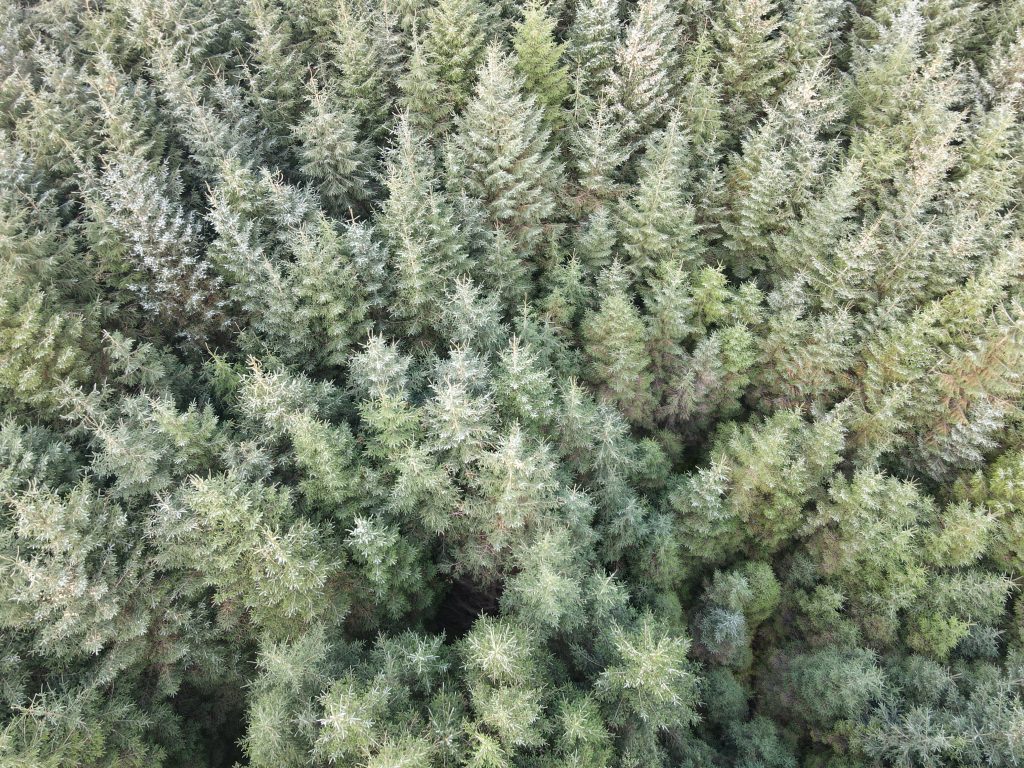Carbon Offset In Ireland Measured
Fintan Riordan, owner of Cork Christmas Trees has been growing trees for over 30 years and is a member of the Carbon Credit Group in Ireland. We are publishing current up-to-date figures for how carbon offset is calculated. With over 360 acres of forestry and over 30 acres of Christmas trees, our growing methods are unique and not what you see around most farms. We will be using our own plantation for this case study.
Note – This report, calculations and findings are not to be reused or copied in any form without permission of the author.
This report was originally published on 28th January 2020
Case Study
We are using our 360 acres of forestry and over 30 acres of Christmas trees as a case study for calculations. Our growing methods are unique and not what you see around most farms. We will explore how the running of our trees increases the carbon offset multiple later. Carbon calculations have been a worldwide collaboration between, the University of Limerick & Dublin, British Columbia of Columbia, Queensland of New Zealand, Florida, Georgia and many more.
How Is Carbon Calculated in Ireland?
A Tree serves 2 purposes for climate change;
- A tree sequesters CO2 (The stem of the tree accounts for 60% of sequestering)
- A tree stores carbon in the roots (Accounts for 40% of sequestering)
Here is the calculation in Ireland;
1 hectare of 30-year-old forestry sequesters a total of 20 tonnes of C02 every year.
- 15 Tonnes of the total 20 Tonnes is sequestered through the tree.
- 5 Tonnes of the total 20 Tonnes is carbon stored in the roots.
In Ireland, we calculate on a more sceptical side of 20 tonnes per hectare. In New Zealand, they calculate 1 hectare of 30-year-old forestry sequesters and 26 tonnes of CO2 annually.
Example;
Cork Christmas Trees has 360 acres (145.687 hectares) of mature forestry which calculates around 2,900 tonnes of Carbon sequestered annually.
Spruce trees are scientifically proven to be the best tree for sequestering CO2. Most of the 360 acres comprise of Spruce.
Over 30 years, this plantation of 145 hectares will sequester 600 tonnes of C02 per hectare or 87,000 tonnes of CO2.

Now for Christmas Trees – This is the Interesting Part
Cork Christmas Trees has 35 acres (14 hectares) of Christmas trees. The trees will be much smaller than its mature forestry and comprise a mix of 2ft-30ft trees. The average height of trees on Cork Christmas trees plantation is 10ft which is about one-third the size of a 30-year-old forestry spruce.
This calculates 6.6 tonnes of Carbon per hectare at Cork Christmas Trees Farm. The trees comprise of mainly Nordmann and Noble Fir.
- A total of 92 tonnes of CO2 is sequestered every year. There is another addition to this figure which we will explore below.
- Over 30 years of this rotational crop, a total of 2,772 tonnes of CO2 is sequestered.

Now Here Is what makes Christmas trees more interesting;
- The Christmas tree farm focuses on retail which means trees will be implanted every year between stumps. (Stumps and roots are left in the ground and are built up over many rotations) This is additional Carbon stored in the ground.
- Branches & leaves account for 12% of the carbon (From the overall 60% of sequestering) All these trees need to be pruned every year, where the branches and needles will naturally decompose into the ground.
- Pasture – 1000m of ditches (uncultivated wild ground) accounts for 2.95 tonnes of carbon storage. Cork Christmas trees has a total of 4,600 m of ditches surrounding the whole perimeter. This is an extra 13.57 tonnes of Carbon storage which now brings the total figure to 105 tonnes.
- Organic methods – the trees are surrounded by grass grazed or mowed by Shropshire sheep. This helps the organic matter and structure of the soil, thus better carbon storage. Studies have shown that a .1% increase in organic soil matter can equate to a whopping 9.9 tonnes of carbon storage. The carbon will not be broken up and will be locked in when it comes to Christmas tree farms. The land will also not be ploughed. Ploughing land can break up carbon storage and release it.
- Aquatic Zones – Christmas trees drain solid and strengthen the soil structure. Cork Christmas Trees Farm is adjoined by the stunning river Lee. The trees help protect the soil from flooding.
- What about when the tree is cut? The tree stores carbon even after it is cut. This is also the case for commercial timber. A Christmas tree can then be recycled for mulch stored in the ground. Dont forget the stump and off-cut branches help naturally store carbon.
- Replanting – For every tree cut, another two trees are planted.

What about a pot-grown tree? This doesn’t do much really sequestering. First of all there not at a mature height. They are struggling while growing in a pot. Also, the soil structure from the farm is released when they are lifted and the soil structure gets released when they are repotted.

Conclusion
We hope the above case studies have helped you learn all the benefits of Christmas trees against climate change. All the calculations above are accredited by experts in Carbon offset worldwide.
There is only one way to reverse the damage done to the universe. And that’s to plant trees and just leave some things to get wild. Ditches, wild grass and other forage for sheep surround our Christmas tree farm. We also have stunning specimens of oak, and sycamore over 100 years old. Visit our Christmas tree farm to see it all.
All findings and calculations were collected by Fintan Riordan who is an avid Christmas tree grower, forester and a member of the Carbon Credit Group in Ireland, Organic Farming Association and Christmas Tree Growers Association.







